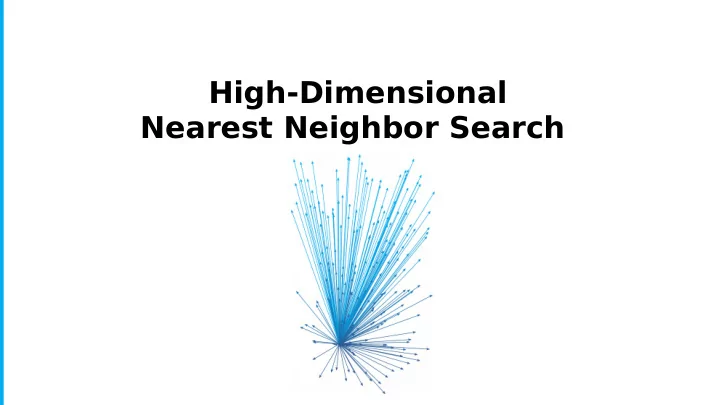

High-Dimensional Nearest Neighbor Search
High-Dimensional Nearest Neighbor Search Who? ● About Cliqz and me – What? ● Problem statement – Why? ● Applications – How? ● Exact solutions in low dimensions – Approximate solutions in high – dimensions
Who? – Cliqz and Me Cliqz ● Builds privacy-focused browsers – Manages its own search index – Me ● Erik Larsson – Software engineer – Search backend – Almost 2 years at Cliqz –
What? – Problem Statement Data (D): ● Many vectors (millions or billions) – Input (Q): ● One query vector (not necessarily – from D ) Output: ● The k vectors from D that are – closest to Q
Why? – Applications Reverse image search ● Represent image by a vector – [245, 245, 242, ...] Pixel values arranged in a vector – More advanced features (SIFT, – SURF, ORB) Similar vectors ↔ similar images –
Why? – Applications kNN classifjcation ● Input data with known labels – Represent input objects by vectors – Assign new unseen object the label – of its k nearest neighbors Regression – Fast and simple baseline ●
Why? – Applications Plant classifjer ● Map images of plants to vectors – Do a NN lookup with an unknown – query image Assign label of closest vector(s) –
Why? – Applications Similar queries at Cliqz ● Answer new, unknown queries by – considering similar, known queries Queries with difgerent phrasing but – similar meaning Map query to vector (word2vec, tf- – idf vectors) NN-lookup – Map back to queries –
How? – Exact Solutions Linear scan ● Conceptually easy – No extra space for index – v0 v1 v2 v3 v4 v5 v6 ... vN Slow – Spatial partitioning ● Divide space into disjoint subsets – q Divide and conquer –
How? – Spatial Partitioning Kd-tree ● Binary tree – Each node splits the space with half – of the vectors on each side Search by traversing tree from root – down to leaf Ball tree ● Similar to Kd-tree – Cover space with “balls” containing – all points within a specifjc radius
How? – High-Dimensional Vectors 100-1000 dimensions ● Curse of dimensionality ● Many methods scale poorly as the – dimension increases Considering one coordinate at a – time is no longer enough Splitting random data with a plane ● In 2d/3d most vectors end up – reasonably far away from the plane In 100d most vectors end up pretty – close to the plane
How? – High-Dimensional Vectors Ways forward ● Same algorithms, slower – Something more clever/complicated – Make the problem simpler –
How? – High-Dimensional Vectors Ways forward ● Same algorithms, slower – Something more clever/complicated – Make the problem simpler – Return vectors that are pretty ● close
How? – Approximate Solutions Annoy – A pproximate n earest n eighbors o h ● y eah A forest of kd-trees with non-axis-aligned – splitting planes Search in all trees simultaneously – Search parameter decides how many – nodes are visited Nice UI (C++ with python bindings) – Used by Spotify for music – recommendations Previously used at Cliqz for similar queries – https://github.com/spotify/annoy – https://github.com/spotify/annoy
How? – Approximate Solutions Proximity graph ●
How? – Approximate Solutions HNSW – H ierarchical N avigable -S mall ● W orld Graph-based: layers of proximity – graphs (similar to skip list) Greedy search in each layer – Elements inserted one by one by – searching in so far constructed index Yu. A. Malkov and D. A. Yashunin: – Effjcient and robust approximate nearest neighbor search using Hierarchical Navigable Small World graphs
How? – Approximate Solutions granne – g raph-based r etrieval of ● a pproximate n earest ne ighbors Based on HNSW – Optimized index construction – Hybrid RAM/disk usage – Index billions of vectors – Rust with python bindings – https://www.interglot.com/dictionary/sv/en/search?q=granne Used in the Cliqz search backend to – serve similar queries https://github.com/herrerik/granne –
Recapitulation The (Approximate) Nearest ● Neighbor Problem has many interesting applications. A few fundamentally difgerent ● methods Best methods depends on ● dimensionality, data size and structure
High-Dimensional Nearest Neighbor Search
Recommend
More recommend